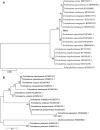Control Effect and Mechanism of Trichoderma asperellum TM11 against Blueberry Root Rot
- PMID: 37725898
- PMCID: PMC10561078
- DOI: 10.33073/pjm-2023-034
Control Effect and Mechanism of Trichoderma asperellum TM11 against Blueberry Root Rot
Abstract
Fusarium oxysporum is the primary pathogen of blueberry root rot; furthermore, we found that Fusarium commune can also cause root rot in blueberries. Trichoderma spp. is widely used to control plant diseases. We isolated Trichoderma asperellum (TM11) from blueberry rhizosphere soil to explore its control effect and mechanism on F. oxysporum and F. commune. We found that the inhibitory effects of TM11 volatiles and broth metabolites on F. oxysporum were significant, but only F. commune volatile metabolites had a significant inhibitory effect on its growth. Twelve known antimicrobial metabolites were detected from the methanol extract of TM11 fermentation broth by HPLC-MS. TM11 lysed and coiled around the hyphae of F. oxysporum and F. commune. The pot experiment showed that TM11 had significant control effects against F. oxysporum and F. commune, and inoculation of TM11 prior to that of F. oxysporum and F. commune was more effective. The TM11, TM11 and F. oxysporum, or F. commune and distilled water treatments had different effects on the activities of superoxide dismutase, peroxidase and catalase, and the enzyme activity levels exhibited the following order: TM11 > TM11 and F. oxysporum or F. commune > distilled water. The results showed that TM11 provided effective control of blueberry root rot.
Keywords: Trichoderma asperellum; biocontrol mechanisms; blueberry root rot; pot tests.
© 2023 Si Li et al., published by Sciendo.
Conflict of interest statement
The authors do not report any financial or personal connections with other persons or organizations, which might negatively affect the contents of this publication and/or claim authorship rights to this publication.
Figures






Similar articles
-
Rhizosphere microorganisms of Crocus sativus as antagonists against pathogenic Fusarium oxysporum.Front Plant Sci. 2022 Nov 22;13:1045147. doi: 10.3389/fpls.2022.1045147. eCollection 2022. Front Plant Sci. 2022. PMID: 36483959 Free PMC article.
-
Bacillus velezensis BVE7 as a promising agent for biocontrol of soybean root rot caused by Fusarium oxysporum.Front Microbiol. 2023 Oct 20;14:1275986. doi: 10.3389/fmicb.2023.1275986. eCollection 2023. Front Microbiol. 2023. PMID: 37928669 Free PMC article.
-
Phylogenetic analysis of plant-pathogenic and non-pathogenic Trichoderma isolates on maize from plants, soil, and commercial bio-products.Appl Environ Microbiol. 2025 Mar 19;91(3):e0193124. doi: 10.1128/aem.01931-24. Epub 2025 Feb 27. Appl Environ Microbiol. 2025. PMID: 40013788 Free PMC article.
-
The cardamom-Fusarium pathosystem: current knowledge and future directions.World J Microbiol Biotechnol. 2025 Jun 4;41(6):189. doi: 10.1007/s11274-025-04426-3. World J Microbiol Biotechnol. 2025. PMID: 40465016 Review.
-
Signs and symptoms to determine if a patient presenting in primary care or hospital outpatient settings has COVID-19.Cochrane Database Syst Rev. 2022 May 20;5(5):CD013665. doi: 10.1002/14651858.CD013665.pub3. Cochrane Database Syst Rev. 2022. PMID: 35593186 Free PMC article.
Cited by
-
©Relationship between endophytic fungal diversity and colonization and soil factors of cultured blueberry roots in Guizhou Province, Southwest China.Arch Microbiol. 2024 Feb 1;206(2):86. doi: 10.1007/s00203-023-03808-1. Arch Microbiol. 2024. PMID: 38302781
-
Fungal Biocontrol Agents in the Management of Postharvest Losses of Fresh Produce-A Comprehensive Review.J Fungi (Basel). 2025 Jan 20;11(1):82. doi: 10.3390/jof11010082. J Fungi (Basel). 2025. PMID: 39852501 Free PMC article. Review.
References
-
- Abdelhai MH, Awad FN, Yang Q, Mahunu GK, Godana EA, Zhang H. Enhancement the biocontrol efficacy of Sporidiobolus pararoseus Y16 against apple blue mold decay by glycine betaine and its mechanism. Biol Control. 2019 NaN;139:104079. https://doi.org/10.1016/j.biocontrol.2019.104079.
-
- Abdel-Kader M, El-Mougy N, Lashin S. Essential oils and Trichoderma harzianum as an integrated control measure against faba bean root rot pathogens. J Plant Prot Res. 2011 NaN;51(3):306–313. https://doi.org/10.2478/v10045-011-0050-8.
-
- Ahsan T, Chen J, Zhao X, Irfan M, Wu Y. Extraction and identification of bioactive compounds (eicosane and dibutyl phthalate) produced by Streptomyces strain KX852460 for the biological control of Rhizoctonia solani AG-3 strain KX852461 to control target spot disease in tobacco leaf. AMB Express. 2017 NaN;7(1):54. https://doi.org/10.1186/s13568-017-0351-z. - PMC - PubMed
-
- Al-Askar AA, Saber WIA, Ghoneem KM, Hafez EE, Ibrahim AA. Crude citric acid of Trichoderma asperellum: tomato growth promotor and suppressor of Fusarium oxysporum f. sp. lycopersici. Plants. 2021 NaN;10(2):222. https://doi.org/10.3390/plants10020222. - PMC - PubMed
-
- Arai M, Han C, Yamano Y, Setiawan A, Kobayashi M. Aaptamines, marine spongean alkaloids, as anti-dormant mycobacterial substances. J Nat Med. 2014 NaN;68(2):372–376. https://doi.org/10.1007/s11418-013-0811-y. - PubMed
MeSH terms
Substances
Supplementary concepts
LinkOut - more resources
Full Text Sources
Miscellaneous
